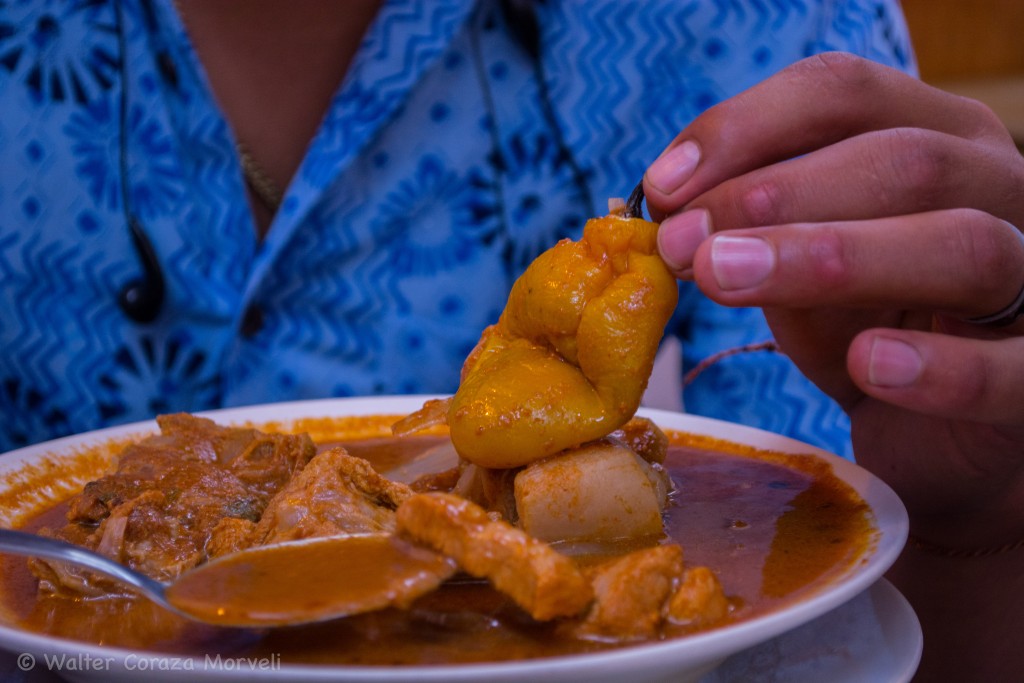A Treasure from Southern Peru, Adobo

Every chance I get to eat a Cusco-style adobo I am pleasantly surprised by its flavor and combination of texture. From the first moment when I see the large bowl filled with a red broth, spicy and fragrant, in which are submerged large chunks of pork. On its surface, soft pieces of onion dance with a colorful, whole rocoto (hot pepper). It is a fiesta and it all easily seduces my palate.
In Cusco you will find adobo for sale year round. Its name appears on the signs for the restaurants that sell chicharrón (crispy, deep-fried morsels of pork) as well as in some picanterías . It draws the eyes of passersby.
This traditional dish is also present in the many gastronomic fairs held throughout the year in Cusco. They happen on weekends or during any major festival within the city. The majority of the city goes to these events. They drink, dance, and have fun. During these occasions the sale of adobo goes up. People call the dish “levanta muertos” (raise-the-dead) because of the boiled rocoto that when you open it explodes with spiciness that fills the dish.

During cold and rainy days it is pleasing to find adobo in different parts of the city. These include San Andrés, Tres Cruces, and Pampa del Castillo where a variety of chicharronerías (places specializing in chicharrón) have set up, such as El Rey, Los Mundialistas, Porkis and many more. In them you can enjoy a large bowl of adobo. If you like the spice of hot peppers it will seem stupendous to you. Of course its exact flavor will vary according to the cook and the place.
I vividly remember a bowl of adobo I had in Calca. It was during the feast of the Virgin of Asunta. At night it is party time, but in the morning the town fills with merchants. Around 10 AM I went into a restaurant where they offered adobo. The brought me a bowl. It looked very good, steam was rising from it. I like my adobo hot. Not only did it shine in the light it let of a tempting smell.

My first spoonful of soup told me it was perfectly salted. I could taste the concentrated meat broth and the pieces of onion melted in my mouth. The pieces of pork were very tender and I could taste a light flavor from the garlic and the chicha that went into making the adobo. How could I ever forget the wondrous combination of the soup chased with Oropesa bread.
There are always reasons to have a good adobo. In the homes of Cusco it is a tradition to prepare adobo for fiestas, for New Years, and for birthdays and family gatherings. All of its flavor brings memories.
Adobo is a traditional dish throughout southern Peru (Arequipa, Tacna and Cusco. It is frequently consumed and its flavor varies according to place. No one knows exactly where adobo was first made but you can be sure that as years pass this traditional dish will continue to please people served a big steaming bowl of it. It will continue to pass from generation to generation.





If you say “Cusco-style adobo” in Arequipa, you may get lincheado. I’m sure you can get adobo in Cusco, just like you can get tacu tacu or seco de cordero in Cusco. And granted I’m a gringo, but I’ve never heard any region claim adobo from AQP, where it is “tradition” to eat it every single Sunday, and the tourist restaurants serve it every single day.
Besides the origins argument however, this is an excellent description of the sumptuous flavor!
Thank you, Colin. You are right. We would get strung up in Arequipa. But the vigor of Arequipa’s claim does not change a complex history in the Southern part of Peru and neighboring Bolivia in which variants of dishes under the same name are found in different places. Origins are extremely difficult to prove and ultimately matter less than the fact that different cities and their hinterlands have different versions of a common cultural core. They too have historical merit and deserve recognition. I would hope that we could state that without people feeling somehow we are disparaging such a marvelous city and region as Arequipa or conversely forgetting that the custom of eating adobo is as strong and deep in Cusco as it is in Arequipa
David